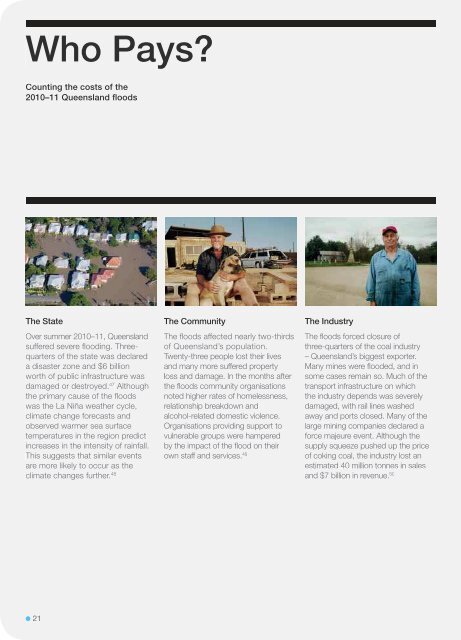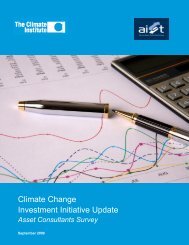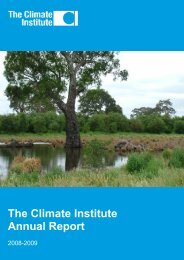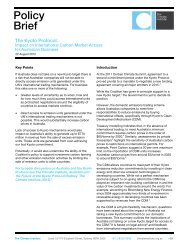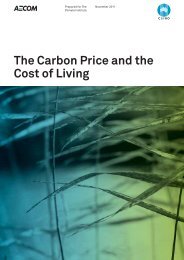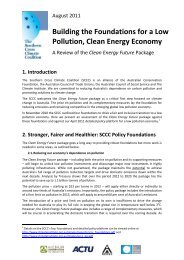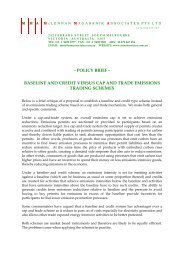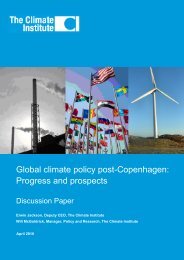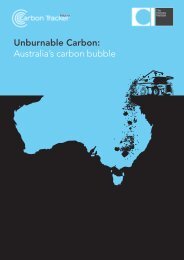Coming Ready or Not - The Climate Institute
Coming Ready or Not - The Climate Institute
Coming Ready or Not - The Climate Institute
Create successful ePaper yourself
Turn your PDF publications into a flip-book with our unique Google optimized e-Paper software.
Who Pays?<br />
Counting the costs of the<br />
2010–11 Queensland floods<br />
Businesses not directly affected by flooding found<br />
that the flow-on consequences were much greater<br />
than they had initially anticipated.<br />
<strong>The</strong> State<br />
<strong>The</strong> Community<br />
<strong>The</strong> Industry<br />
<strong>The</strong> Business<br />
<strong>The</strong> Insurer<br />
<strong>The</strong> Citizen<br />
Over summer 2010–11, Queensland<br />
suffered severe flooding. Threequarters<br />
of the state was declared<br />
a disaster zone and $6 billion<br />
w<strong>or</strong>th of public infrastructure was<br />
damaged <strong>or</strong> destroyed. 47 Although<br />
the primary cause of the floods<br />
was the La Niña weather cycle,<br />
climate change f<strong>or</strong>ecasts and<br />
observed warmer sea surface<br />
temperatures in the region predict<br />
increases in the intensity of rainfall.<br />
This suggests that similar events<br />
are m<strong>or</strong>e likely to occur as the<br />
climate changes further. 48<br />
<strong>The</strong> floods affected nearly two-thirds<br />
of Queensland’s population.<br />
Twenty-three people lost their lives<br />
and many m<strong>or</strong>e suffered property<br />
loss and damage. In the months after<br />
the floods community <strong>or</strong>ganisations<br />
noted higher rates of homelessness,<br />
relationship breakdown and<br />
alcohol-related domestic violence.<br />
Organisations providing supp<strong>or</strong>t to<br />
vulnerable groups were hampered<br />
by the impact of the flood on their<br />
own staff and services. 49<br />
<strong>The</strong> floods f<strong>or</strong>ced closure of<br />
three-quarters of the coal industry<br />
– Queensland’s biggest exp<strong>or</strong>ter.<br />
Many mines were flooded, and in<br />
some cases remain so. Much of the<br />
transp<strong>or</strong>t infrastructure on which<br />
the industry depends was severely<br />
damaged, with rail lines washed<br />
away and p<strong>or</strong>ts closed. Many of the<br />
large mining companies declared a<br />
f<strong>or</strong>ce majeure event. Although the<br />
supply squeeze pushed up the price<br />
of coking coal, the industry lost an<br />
estimated 40 million tonnes in sales<br />
and $7 billion in revenue. 50<br />
Six months after the floods,<br />
businesses affected directly were<br />
still operating below business as<br />
usual owing to the impacts on<br />
their customers, po<strong>or</strong> consumer<br />
confidence, low demand, insurance<br />
and construction delays, flow-on<br />
impacts from the damage to maj<strong>or</strong><br />
resource projects, and difficulty<br />
accessing finance. Businesses not<br />
directly affected by flooding found<br />
that the indirect consequences were<br />
much greater than they had initially<br />
anticipated. 51<br />
Insurance companies received 58,000<br />
claims w<strong>or</strong>th $2.4 billion. 52 However,<br />
many households lacked coverage,<br />
while others found that their policy’s<br />
definition of ‘flood’ excluded<br />
compensation f<strong>or</strong> this event. 53<br />
Premiums in many areas of the state<br />
tripled. Sunc<strong>or</strong>p Insurance placed<br />
an embargo on new covers in Roma<br />
and Emerald, two towns f<strong>or</strong> which the<br />
floods were the third in three years. 54<br />
<strong>The</strong> costs of the floods were felt well<br />
beyond state b<strong>or</strong>ders. <strong>The</strong> damage to<br />
Queensland’s agricultural production<br />
sent fruit and vegetable prices up<br />
by nearly 15 per cent, and drove<br />
up inflation. 55 <strong>The</strong> Commonwealth<br />
Government imposed a flood levy<br />
on income over $50,000 to raise<br />
$1.8 billion f<strong>or</strong> reconstruction. In<br />
total the floods were estimated to<br />
have knocked $9 billion and 0.5 of a<br />
percentage point off Australia’s GDP<br />
in 2010-11. 56<br />
.<br />
21<br />
22


